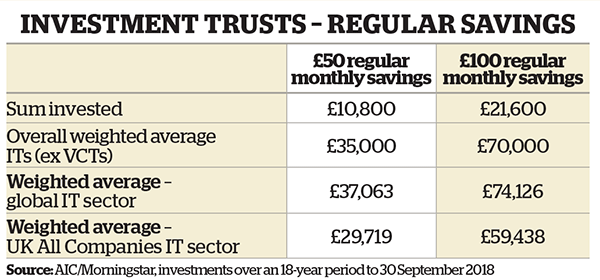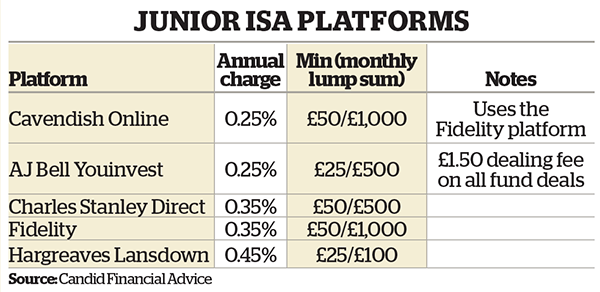How can I build a nest egg for my children? Ease growing pains with savvy saving
Parents who invest savings wisely can ease the strain on young adults. Sam Barrett outlines the variou…
11th December 2018 11:30
by Sam Barrett from interactive investor
Parents who invest savings wisely can ease the strain on young adults. Sam Barrett outlines the various options.

The costs that a young person faces in early adulthood are on the rise: a university degree, a wedding and a first home are all getting more expensive. However, investing for a child’s future can help them get off to a good financial start.
Among the financial hurdles today’s younger generation face are student debt at an average of £50,800, according to the Institute for Fiscal Studies; mortgage deposits at £33,127 on average, according to the Halifax’s First-Time Buyer Review; and wedding expenses of £30,111, according to Brides magazine.
Get an early start
Given the eye-watering scale of these costs, putting money aside as early as possible can make a big difference. “The earlier you start saving and investing for a child’s future, the better,” says Ed Monk, associate director for personal investing at Fidelity. “With an 18-year time horizon, your money has a great opportunity to grow.”
Start early and the added input of compound interest means you don’t need to save as much overall. Take the average university debt of £50,800, for example. You would need to save £147 a month for 18 years to cover this, assuming an annual return of 5%. Cut the time horizon to 10 years and your monthly contribution would need to more than double to £326, which would amount to a total contribution of £39,120, compared with £31,752 for the longer period.
Introducing a child to saving and investing, as well as taking some of the financial pain out of bills, can pay dividends that go far beyond building up a tasty lump sum. “Helping a child develop a savings habit can give them a really valuable skill for life,” says Anna Bowes, director of savings research site Savings Champion. “A recent report from the Office for National Statistics found that 53% of 22 to 29-year-olds had no money saved in a savings account or Isa in 2014/16, up from 41% in 2008/10. This is a very worrying trend, given the expenses young people face.”
- Prudent Parent: Build a ‘rainy day baby’ fund for parental leave
Take the risk
The other benefit of the lengthy timescales involved with saving and investing for children is that you can afford to take the higher levels of risk associated with stock market investments.
Sarah Coles, a personal finance analyst at Hargreaves Lansdown, explains: “Around 60% of people who have opened a Junior Isa (Jisa) have opted for cash. This may make sense if your child is in their teenage years, but if you’re investing for five years or more, cash is simply the wrong choice. Stockmarket investments can be volatile, but in the long run, they are likely to grow faster than cash.”
Underlining her point, figures from Fidelity International show that over 18 years, a £10,000 investment in the FTSE 100 index would have grown to £22,676, compared with just £11,825 if it had been left in a savings account. Monk says: “With a time horizon of 18 years, you can ride out the peaks and troughs of equity investments. I wouldn’t advocate finding the riskiest stock market out there, but you can certainly afford to look at something with a bit more spice.”
His advice is supported by performance figures from the Association of Investment Companies (see box). These show that while investing £100 a month into the IT UK all companies sector yielded a return of £59,439 after 18 years, investors prepared to take the additional risk associated with the IT global sector secured an additional £14,687 and an overall return of £74,126.
- Ask Money: how can we help our daughter financially?
Save regularly
Investing regularly helps manage some of the risks associated with the stock market. Justin Modray, director of Candid Financial Advice, explains: “Investing monthly can smooth out the effects of stock market volatility. In a falling market, it’s much less painful than investing a lump sum at the outset.”
Investing regularly is beneficial because it enables an investor to buy a greater number of shares or units when the market is falling. When stockmarket fortunes start heading upwards again, this additional exposure can help supercharge returns.
When deciding where to save or invest, it’s important to consider how the money might be used in the future. Anna Sofat, founder of financial adviser Addidi Wealth, says that although there are investments specifically for children – Jisas, for example – sometimes it’s more appropriate for a parent to hold money intended for children in their own name.
“Putting an investment in a child’s name will mean they can’t access it until they are 18,” she says. “This might work well if you’re investing for university fees, but not if it’s for school fees. The other benefit of investing in your own Isa is that you have more control over how it is spent. Not all 18-year-olds are as responsible as you would like.”
Alongside this, the way savings are treated from a tax perspective should be factored into deliberations, with your position in regard to income, capital gains and inheritance tax all up for consideration. However, it’s sensible not to let tax savings override more important – and potentially costlier – factors such as controlling access to the money.
- Fifth of parents give children inheritance early
Start with savings
Although the timescale involved in saving for a child means the stock market is ideal for building a nest egg, savings also have an important role to play.
Bowes says: “A savings account can help a child develop good money management skills. If you are happy to opt for an account that is more restrictive in terms of access or the amount you can pay in, you can get some excellent rates on children’s savings accounts.”
The Halifax’s Kids’ Monthly Saver account, for example, available for children up to age 15, pays 4.5% interest. To qualify for this, a child needs to save between £10 and £100 a month, and be prepared to leave the money tied up for a year. At the end of that period, the balance will be transferred into a Kids’ Saver account, currently paying 2%.
Plumping for a cash Jisa can also boost a child’s interest rate. The top payers, according to Savings Champion, are Coventry Building Society, with a rate of 3.6%, and Darlington Building Society, at 3.25%. Again, though, there are restrictions: Jisa rules limit the amount you can pay in (£4,260 in 2018/19) and tie up money until the child turns 18.
Accessing these higher rates can be very beneficial for a child’s savings pot. For example, assuming a rate of 3.6%, putting away just £10 a month could grow their pot to £3,042 when they reach 18, accumulating nearly £900 in interest on the way.
Although not strictly a savings product, NS&I premium bonds are another low-risk option for a child’s savings pot. These give them a chance to win a tax-free prize of up to £1 million, plus your money back when you want it.
Each £1 bond has a 24,500-to-one chance of winning a prize. This equates to an annual prize fund interest rate of 1.4%. Probabilistic calculations are likely to determine whether you think this stacks up well against a higher guaranteed return from a savings account.
On page 2: stockmarket plays, Jisa alternatives, tax considerations and pension options
Stockmarket plays
A variety of different products are available if you’re looking to invest for a child in the stock market. Modray suggests that using a child’s Jisa allowance is a sensible first step. “It’s straightforward and tax-efficient,” he says. “The child can take control when they reach age 16, and at age 18 either withdraw monies or roll it into a conventional adult Isa.”
The annual allowance is £4,260 in 2018/19, which spans across cash Junior Isas too. This allowance also applies if the child was born between September 2002 and January 2011 and holds a Child Trust Fund. You can go direct to a provider, but Modray recommends using an investment platform such as AJ Bell Youinvest, Cavendish Online or Hargreaves Lansdown. These represent a cost-effective way to access stockmarket investments, while allowing you to mix and match from a wide range of funds and investment trusts.
Platform costs are relatively low, but weigh them up. James Budden, director of retail marketing and distribution at Baillie Gifford, says: “Think about how much you are investing and how you want to use a platform. A dealing charge of £1.50 is significant if you only invest £25 a month.”
- Inheritance: average is £11,000
Jisa alternatives
You can also invest outside of the Jisa wrapper, perhaps because a child’s allowance has already been used up or because you want more flexibility. Where you do forgo the Jisa wrapper and you’re happy for a child to have control at age 18, you can designate an account or set one up in a bare trust (see below).
Again, plenty of options are available. For example, investment trusts, including Baillie Gifford, F&C and Witan, offer savings schemes designed specifically for children, with both charges and contributions kept to a minimum. Budden says: “Our children’s savings scheme has a minimum monthly investment of £25, and allows you to invest across a range of our investment trusts. There are no additional charges other than those relating to the underlying investments.”
Another tax-efficient option is a friendly society child bond. These are offered by the likes of Foresters, One Family and Scottish Friendly. They allow you to invest up to £25 a month over 10 years or until your child’s 18th or 21st birthday.
Although such a bond could top up a child’s tax-free savings, these bonds have significant disadvantages. Modray says: “They often have a poor range of investments compared with those available through a Jisa. Many only offer a with-profits fund.”
Whatever your investment strategy, it’s important to keep an eye on performance. Monk recommends an annual review. “You don’t want to chop and change too much or spook yourself if performance falters, but make sure your investment is performing as expected.”
After all, with the costs associated with adulthood constantly rising, ensuring a child’s savings and investments are performing well will guarantee a much-needed financial head start.
- Ambitious for a home of your own? Property-owning parents are key
Crucial tax considerations for parents and grandparent investors
Very few children have to pay tax, but if you’re looking to invest on their behalf, you need to weigh up the tax treatment of child savings options carefully, as it can have implications for your own finances.
Parents need to be particularly careful. “If parents gift money and the annual income exceeds £100, it will be classed as theirs for tax purposes,” says Justin Modray, director of Candid Financial Advice. “Using a tax-efficient investment such as a Jisa can prevent this.”
Investments outside a Jisa wrapper also need to be carefully considered from a tax perspective.
Where you want the money to be for a child, you can choose to set up a designated account, giving you control over the money before the child is 18, or a bare trust, where it is ringfenced for the child until they reach age 18.
Both options ensure the investment goes to the child at age 18, but tax treatment varies.
Modray explains: “A designated investment will be taxed as if it belongs to the parent or grandparent. Conversely, an investment in a bare trust is taxable as the child’s.”
Note that there are differences that have implications for inheritance tax planning. Investments held in designated accounts remain in the adult’s estate, while those held in a bare trust will usually fall out of their estate after seven years.
Principal pension options for children
A pension a child won’t be able to access until they are at least 55 years old might not enthuse them as much as the latest Lego or must-have technology, but investing even a small amount when they are little can make a significant difference to their fortunes.
“Non-taxpayers, including children, have an annual pension allowance of £3,600,” says Anna Sofat, founder of Addidi Wealth. “As this includes 20% tax relief, you would only need to pay in £2,880 to get the full contribution.”
Given the length of time this money has to grow, the results can be impressive. For example, figures from Hargreaves Lansdown show that if the full £3,600 investment was made every year and grew at 5% a year until a child turned 18, it could be worth more than £106,000 at that point. Left until age 65 and assuming the 5% growth rate continues, the pension pot could grow to more than £1 million.
Sofat says: “Children might not think much of a pension when they’re small, but they’ll like it when they’re in their 20s and don’t need to contribute so much to a pension themselves.”


This article was originally published in our sister magazine Money Observer, which ceased publication in August 2020.
These articles are provided for information purposes only. Occasionally, an opinion about whether to buy or sell a specific investment may be provided by third parties. The content is not intended to be a personal recommendation to buy or sell any financial instrument or product, or to adopt any investment strategy as it is not provided based on an assessment of your investing knowledge and experience, your financial situation or your investment objectives. The value of your investments, and the income derived from them, may go down as well as up. You may not get back all the money that you invest. The investments referred to in this article may not be suitable for all investors, and if in doubt, an investor should seek advice from a qualified investment adviser.
Full performance can be found on the company or index summary page on the interactive investor website. Simply click on the company's or index name highlighted in the article.